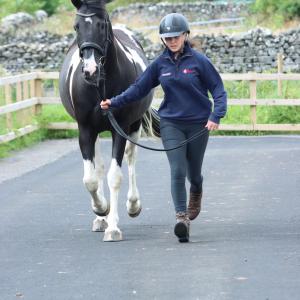
By Vet Emma Trott

After you have found your perfect horse or pony, it is advisable to have a vet perform a pre-purchase examination, or vetting, prior to completion of the sale.
While all vettings will have the same basic steps, the interpretation of any findings is individual to the horse and purchaser, as the aim is to determine if this horse will be suitable for the purchaser’s intended use.
Therefore, it is recommended to have your own vetting done, regardless of any previous vettings the horse has been through.
The same horse may pass a vetting if the purchaser intended only to hack out and pleasure ride but may not be suited for a showjumping or eventing home.
We would advise that all ridden horses undergo a 5 stage vetting to ensure a thorough assessment can be made.
A 5 stage vetting will typically take between 90 minutes and two hours.
Horses should be stabled prior to the examination, and the stable must be dark enough to allow for an ophthalmic (eye) exam. A suitable surface for a trot up and an arena for the exercise stage will also be required. If the yard does not have suitable facilities, arrangements should be made to take the horse to somewhere else - your vet may have facilities they can use.
It is advisable to use a vet that is not associated with the seller of the horse to avoid conflict of interest. If the examining vet has prior veterinary knowledge of the horse, they must seek permission to disclose the full known history of the horse in question. They will then explain if this history represents a greater risk of developing future problems.
So what happens during a 5-stage examination?
Firstly the horse is identified, and a seller declaration is made regarding any relevant history or medications the horse is on.
Stage 1 - Preliminary Examination
A thorough clinical examination is performed, including but not limited to, assessing the heart, lungs, eyes and skin.
Stage 2 - Trotting Up
The horse is walked and trotted up on a flat hard surface to assess for any abnormalities in their movement. Flexion of all four legs is performed to highlight any lameness. The horse is also backed up and turned in tight circles.
Stage 3 - Strenuous Exercise
The horse is then put through a period of strenuous exercise. This allows the vet to assess the horse's gaits and see how their heart rate and breathing effort change. It is important to sufficiently increase the heart rate so that this can be assessed. We advise that the exercise phase is ridden so they can be assessed under saddle, but for horses that can’t be ridden, an examination on the lunge may be carried out. This will be noted on the examination record.
Stage 4 - Rest
The horse is untacked and allowed to recover. During this time the horse’s respiratory and heart rate are monitored.
Stage 5 - Second Trot Up
The horse then undergoes a second trot up to assess for any deterioration in movement after exercise.
We are sometimes requested to complete a two-stage vetting. This is a shorter exam, with only stages one and two carried out. This is also known as a “limited prior to purchase examination”. Prior to completing a two-stage vetting the vet will explain the limitations of this exam and request that the purchaser signs a disclaimer acknowledging these.
After completing a vetting, the vet will record their findings on the vetting certificate and discuss with the purchaser what this means regarding the horse's suitability.